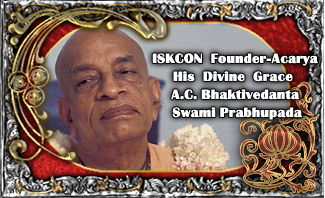Hare Krishna!
Articles and News
- TOVP
- Srila Prabhupada
- GBC
- Announcements
- Message Board
- Advertisements
- Bhaktivedanta Manor
- Ireland
- Appeal
- Dublin
- Book Distribution
- Festivals
- Chanting
- Deity Worship
- Diary
- Education
- Follow Up
- Hari Nama
- In Memoriam
- Life Style
- London
- Nama Hatta
- News from Ireland
- Rathayatra
- Restaurants in UK & Ireland
- Streaming
- Vaishnava Calendar
- Varnasrama
- Vegetarianism
- General News
- Iskcon Educational Services
- Philosophy
- Newsletters
- Food For Life
- Cow Protection
- Youth Activity
Page added on December 12, 2009
“The Mystery of the Edited Booksâ€
9,512 views
Prabhupada said that not a word of his books should be changed. The first edition of Bhagavad-gita As It Is was perfect. With their second edition, the BBT editors have taken the Bhagavad-gita further away from Pra-bhupada’s intentions. The BBT didn’t consult anybody about making their changes.
Or at least some would have you believe. To clarify their actions amid this hailstorm of controversies and allegations, the BBT launched their new website, BBTedit.com, on August 26th. There the editors clearly show the revisions they made to Prabhupada’s books, explain why they made them, and provide an informative background of quotations, historical records, and video interviews.
But what really happened? And if the BBT is faithful to Prabhupada, where did all the controversy come from?
BBT Editor Jayadvaita Swami
First, let’s back up a bit. Although Srila Prabhupada said that the philosophy should not be changed, he clearly wanted editors. He wrote and produced the first canto of Srimad-Bhagavatam on his own in India, but he did it only because he had to. When continuing his preaching in the West, however, he at once enlisted the services of those who came to help. His first book in America, the 1968 abridged version of Bhagavad-gita, was published by Macmillan. Teachings of Lord Chaitanya was produced and typeset by Dai Nippon in Japan. Subsequent books—including a second edition of the first canto of Srimad-Bhagavatam—were edited by his disciples Rayarama, Hayagriva, Satsvarupa, and later Jayadvaita.
Prabhupada also clearly vocalized his intentions. “I wish that all copies, before finally going to the press, must be thoroughly revised and edited so that there may not be any mistakes, especially of spelling and grammar or of the Sanskrit names,†he said.
His disciples complied. Sanskrit editor Pradyumna would indicate the parts of speech in word-for-word translations that Prabhupada left out—for instance, “to Krishna†or “for Krishna†rather than just “Krishna.†Editors would insert translations where Prabhupada quoted Sanskrit verses. They applied standards of consistency, broke long paragraphs into shorter ones, and turned passive voice into active. They changed Indian usage to Western. Prabhupada appreciated all of this. He also expected his editors to catch and correct common dictation errors—for instance, if he quoted the wrong verse number or said something was done by one person when it was really done by another.
But while doing their best to fix errors, the editors—who were new to Sanskrit and to the philosophy—often made their own. “We all made mistakes—me, Hayagriva, Rayarama,†says Jayadvaita Swami, who came onboard in 1972. “And Prabhupada would point them out if he noticed them. Once he was giving a class, using the first edition of the Bhagavatam. When he read that the Yadu dynasty quarreled amongst themselves after drinking liquor made of ‘purified rice,’ he stopped. ‘What is this purified rice?’ he said. ‘It’s putrefied rice. This should be corrected.’â€
Another time, Srila Prabhupada was reviewing a proof for the Krishna book when he found an editorial error. “In KRSNA chapter 87, on page 4, the last line, it is said, ‘known as budbuvasa, which is manifested by Govinda,’†he wrote to Brahmananda Dasa on April 17, 1970. “I do not know what is this editing. The correct word is Bhur-bhuvasvah as it is in the Gayatri mantra and everybody knows it. This ‘budbuvasa’ is an extraordinary word, neither it is Sanskrit nor English, so how it has avoided the vigilance of so many editors?â€
Unfortunately, the BBT could not fix these errors immediately. For one thing, its staff was hard at work on new books—including the famous “seventeen volumes in two months†Sri Chaitanya-charitamrita marathon—and had no time. For another, the early books had been typeset using outdated machines that were no longer working. “We couldn’t have gone back to fix a few words of Bhagavad-gita or other books,†says Jayadvaita Swami. “We didn’t have the typesetting equipment to match them.â€
So fixing the errors had to wait—but finding them didn’t. As ISKCON devotees became more studious in the years from 1972 and on beyond Prabhupada’s passing in 1977, they began to puzzle over many confusing passages in his books. At first they would give some explanation that seemed to make sense—but then they realized that the passages had simply been misedited, and began to point the mistakes out to the BBT.
As more books were published in various languages, translators weighed in too. “Because translators have to read the books more carefully than anyone else, they often found things in their examinations that just didn’t make sense,†says Jayadvaita Swami. “More and more errors accumulated, and devotees began to ask us, ‘Aren’t you going to fix these?’ Finally, we decided to do a careful survey of the original manuscripts and see what needed to be fixed. There was a lot that did.â€
Contrary to some myths propagated today, Jayadvaita Swami’s subsequent revision process was a very transparent one. “First, I consulted with many senior devotees, fellow editors, and devotee Sanskrit scholars,†he says. “Next, I made the changes, sometimes for accuracy, but usually to bring the text closer to Srila Prabhupada’s original manuscript. Finally, for the translations, I typed out a list of all the revisions and sent it out to all the GBC men, sannyasis, temple presidents and other senior devotees in the English-speaking world, along with a cover letter asking for their input. It was probably the widest consultation on anything in the history of ISKCON—and a big effort, considering it was before Internet or email.â€
That year, the GBC formed a committee at their annual meetings that went over the revisions verse by verse, recommending what to include and what not to. Jayadvaita Swami followed these, and only then—in 1983—did the BBT publish the second edition of Bhagavad-gita As It Is.
But although it had been effectively endorsed by the devotee community, various figures throughout the eighties and early nineties spoke out against the book, and perpetrated many myths and controversies about it. Others joined them. Some were propagandists trying to push a political objective or alternative philosophy. Many were people who had legitimate, historical reasons for being unhappy with ISKCON, and who bitterly threw in “changing the books†as just one of the things wrong with the society.
Of course, there were also very thoughtful, sincere individuals who had listened to both sides of the story, considered the issues very carefully, and had genuine concerns and questions. “That’s healthy and good,†says Jayadvaita. “We welcome people we can have meaningful, informative conversations with, whether or not we agree with each other.â€
By the mid 1990s, the BBT were responding to all these parties in various ways. First came the book Responsible Publishing. Next up was the bbt.info webpage Gita Revisions Explained. On it the BBT showed the first, second, and original manuscript versions of every verse that had been complained about on the Internet side by side, along with explanations. Bhagavatam Revisions Examined followed, using the same presentation to show how similar revisions were made to the original 1972 Bhagavatam—during Prabhupada’s lifetime, and with his approval. And on the BBT conference Errors in English Books, anyone could bring up their issues of concern to editor Dravida Dasa.
Now, the BBT has finally launched bbtedit.com, where it presents all the previously released information and more in one easy-to-navigate location. There’s everything you ever wanted to know about how the BBT edits—from articles, to historical quotes from Srila Prabhupada and the disciples who worked with him, to a library of video interviews with BBT editors, Sanskrit staff, and other senior devotees. The site’s premier feature, however, is the scan of the first edition Bhagavad-gita on which Jayadvaita Swami made his revisions. This book was recently found after being lost for many years.
“As a simple, more straightforward alternative to the footnoted edition some have requested, I’ve made annotations explaining my edits,†Jayadvaita says. “And I’ve tried to make them informative rather than argumentative. Many of the comments just point out, ‘Here’s what the original manuscript said,’ and that makes my reasons apparent.â€
He admits that even this will not resolve the issue for everyone, however. “Some people have invested themselves so heavily in the proclamation that these books are bad, that I sense they will never change their minds regardless of what we show them. But for those who just have doubts, and want to understand exactly what happened and come to their own informed conclusion, this site will be very helpful.â€
BBTedit.com’s work is not over yet. The BBT hopes a new series of instructive videos—three explaining the nature of the original manuscripts, one explaining how Srila Prabhupada drew upon predecessor acharyas, and another giving an example of how the editors relied on the Sanskrit commentaries to clear up perplexities in the manuscript—will give people a better understanding of how both the first and second editions of Bhagavad-gita came to be what they are. And Jayadvaita Swami is gradually annotating and uploading his entire Bhagavad-gita manuscript to add to the introduction and preface already online.
And although he knows it won’t change everyone’s minds, he hopes that for sincere, open-minded devotees, it will put the mystery of the edited books to rest. “They deserve to have their questions heard, their concerns taken seriously. And they deserve open and informative answers,†he says. “Through giving these, we hope to demonstrate that the BBT is simply trying to bring devotees closer to Srila Prabhupada.â€
Visit http://friendsofthebbt.org Online Newsletter: http://friendsofthebbt.org/newsletter/Nov09.html
Vegetarianism, Retreats and more

Can a vegetarian diet improve or restore health?
Since the 1960s, scientists have suspected that a meat-based diet is somehow related to the development of arteriosclerosis and heart disease.

Lake Island Retreats
Discover your relationship with your body, mind and soul. Includes Yoga, meditation, massage options, walking and Eastern philosophy.

Hare Krishna Island
The island is 7 miles from Belturbet in north Co. Cavan and 7 miles from Lisnaskea in south Co. Fermanagh

- Most Users Ever Online Is 423 On April 29, 2024 @ 7:54 am
LATEST NEWS HEADLINES
- Lord Jagannatha’s Blessings Return to Nottingham!
- ISKCON UK May Book Distribution Report
- Sankirtan Report – UK&IRL 2025 Campaign
- Contact our Sankirtan Leaders nearest to you to participate on any aspect of book distribution or if you would like more information
- ISKCON UK Official Statement
ALSO IN THE NEWS
 ISKCON UK FUNERAL SERVICES
ISKCON UK FUNERAL SERVICESDear ISKCON UK Devotees During this unpredictable and sensitive time you might be in a situation that you require a priest to render a funeral service but unable to arrange one. HG Kripamoya Prabhu has very kindly compiled a short funeral service that can be used in crisis when no priest is available. This is […]
MORE STORIES
 Prayers to all those who have been affected by the coronavirus
Prayers to all those who have been affected by the coronavirus- Rameshwar Prabhu, a Devotee Warrior
- Once in a Lifetime Offer – Chasing Rhinos with the Swami: Volume Two
- Recommendations for Initiation in the UK
- Cooking for the London Rathayatra 16th June 2019
- The View Of An Irish Hare Krishna On “What It’s All About”
- Be a Pioneer for ISKCON’s 50th UK anniversary!
ADVERTISING
 Click here to see advertised ISKCON projects and devotee business on this site
Click here to see advertised ISKCON projects and devotee business on this siteVaishnava Calendar Reminder Service
 Reminders sent to your email about upcoming events - Ekadasi, Festivals, etc. Click to subscribe.
Reminders sent to your email about upcoming events - Ekadasi, Festivals, etc. Click to subscribe.MORE NEWS HEADLINES